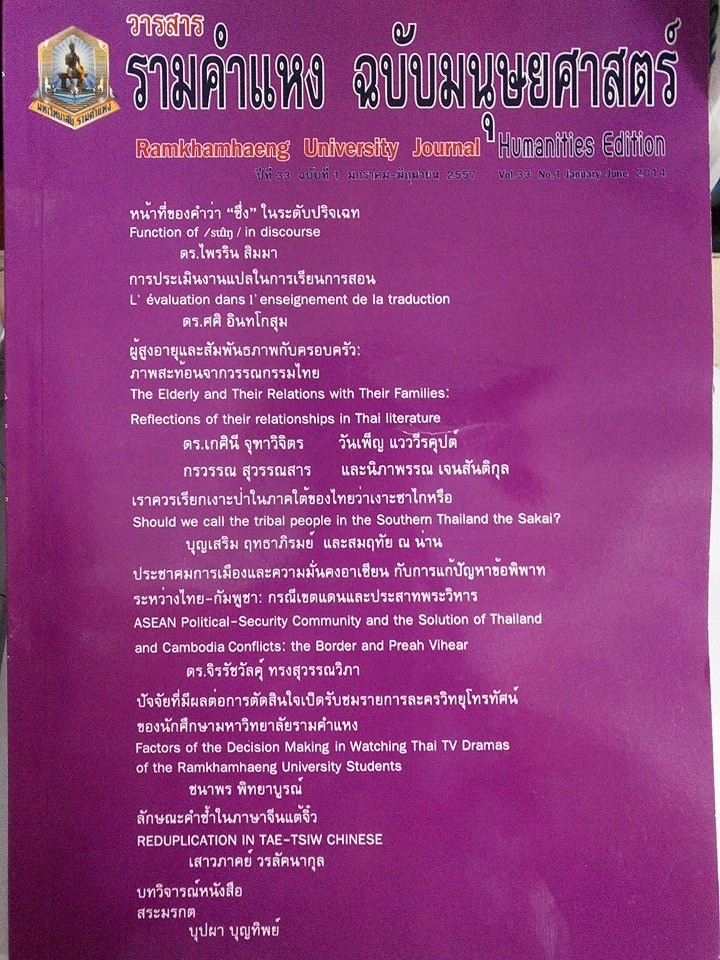หน้าที่ของคำว่า “ซึ่ง” ในระดับปริจเฉท Function of ........ in discourse
Main Article Content
บทคัดย่อ
บทคัดย่อ
บทความวิจัยนี้มีวัตถุประสงค์เพื่อศึกษาหน้าที่ในระดับปริจเฉทของคำว่า “ซึ่ง” ในภาษาไทย โดยการศึกษาพบว่าเมื่อ “ซึ่ง” ปรากฏระหว่างหน่วยถ้อย คำ ๆ นี้ไม่ได้ทำหน้าที่เป็นดัชนีปริจเฉทประเภทเสริมความหรือเป็นเหตุเป็นผลดังที่งานวิจัยก่อนหน้านี้กล่าวไว้ หากแต่ “ซึ่ง” ทำหน้าที่เป็นตัวบ่งชี้เรื่อง โดย “เรื่อง” ที่อ้างอิงถึงอาจเป็นส่วนประกอบใดส่วนประกอบหนึ่งหรือเป็นสารสนเทศทั้งหมดที่ปรากฏในหน่วยถ้อยก่อนหน้า และอาจแสดงโดยการใช้ รูปแทน การซ้ำคำหรือวลี หรือการละไว้ในฐานที่เข้าใจ เนื่องจากคำว่า “ซึ่ง” ในฐานะตัวบ่งชี้เรื่องเป็นคำที่ไม่เปลี่ยนรูป ไม่มีหน้าที่เชิงวากยสัมพันธ์ และมีความหมายเชิงกระบวนการอันนำไปสู่ความเชื่อมโยงระหว่างหน่วยถ้อยและความมีเอกภาพของปริจเฉท เราจึงสามารถพิจารณาได้ว่า คำ ๆ นี้เป็นดัชนีปริจเฉท โดยผู้วิจัยเห็นว่าน่าจะจัดให้อยู่ในประเภทเดียวกันกับดัชนีปริจเฉทที่ ทำหน้าที่แสดงความสัมพันธ์ในระดับโครงสร้างปริจเฉท
This article aims to study the function of /sµ^N/ in Thai discourse. Against what is indicated in a previous research, it is found that when /sµ^N/ appears between utterances, it doesn’t function as a discourse marker with additive and causal meaning, but as a topic marker. The topic marked by /sµ^N/ may be a component or all information expressed in a preceding utterance and it may be referred by the use of substitution, repetition or ellipsis. As the word /sµ^N/ in the function of topic marker is invariable, has no syntactic function and has procedural meaning, which leads to the connection between utterances and to discourse coherence, it can be considered as discourse marker. And, in my opinion, it should be included in the same group as those that function in the discourse structure level.
Article Details

อนุญาตภายใต้เงื่อนไข Creative Commons Attribution-NonCommercial-NoDerivatives 4.0 International License.
ประกาศลิขสิทธิ์จะปรากฏในเกี่ยวกับวารสาร ควรอธิบายสำหรับผู้อ่านและผู้เขียนว่าเจ้าของลิขสิทธิ์เป็นผู้เขียนวารสารหรือบุคคลที่สาม ควรรวมถึงข้อตกลงการอนุญาตเพิ่มเติม (เช่นใบอนุญาตครีเอทีฟคอมมอนส์) ที่ให้สิทธิ์แก่ผู้อ่าน (ดูตัวอย่าง) และควรให้วิธีการรักษาความปลอดภัยหากจำเป็นสำหรับการใช้เนื้อหาของวารสาร


